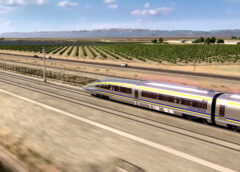Plans for high-speed rail in the United States date back to the High-Speed Ground Transportation Act of 1965. Various state and federal proposals have followed. Despite being one of the world’s first countries to get high-speed trains with the Metroliner service in 1969, it failed to spread.
There are just a few variations of high-speed rail in the United States. One runs along the Northeastern Corridor. The Acela is Amtrak‘s flagship high-speed service between Washington, D.C. and Boston via 16 intermediate stops, including Baltimore, Philadelphia, New York City, and Providence. Acela trains are the fastest in the Americas, attaining 150 mph (240 km/h) which qualifies as high-speed rail, but only on 33.9 miles (54.6 km) of the 457-mile (735 km) route, because it runs along conventional lines with other trains through an aging, crowded corridor. Even with those limitations, one can consider Acela one of Amtrak’s busiest services, second only to the slower and less expensive Northeast Regional. Plans are in the works to improve and modernize the corridor.
There are other variations in operation in the US is what is considered higher speed rail, which means that it is below the 150 mph and above to be consider true high-speed rail.
One system under construction is Brightline, which is the only privately owned and operated intercity passenger railroad in the United States.
Its development started in March 2012 as All Aboard Florida. Construction began in November 2014 and the Fort Lauderdale to West Palm Beach route opened in January 2018. With the 2023 opening of the Miami to Orlando route is when the trains will hit higher speeds.
Other states have proposals for high-speed rail service, such as Texas with their Texas Central Railway Dallas to Houston project with a planned opening of 2026.
On the west coast there are two projects in the works, both are in California.
Brightline West is a proposed privately run high-speed rail route between Las Vegas Valley and Victor Valley, in the high desert area of Southern California. Formerly known as XpressWest, the project is intended to provide an alternative to air and automobile travel between Southern California and Las Vegas, a popular vacation spot for many living in the region. Construction on the route is expected to begin in early 2023 and trains are planned to enter revenue service in 2025. The proposed rail is supposed to link up to Metrolink regional rail and California High Speed Rail service at Union Station after total completion of the project..
The most ambitious and yet problematic high-speed rail project to date. The California High-Speed Rail (CAHSR or CHSR) is a publicly funded high-speed rail system under construction in the U.S. state of California. Its goal is to connect the Anaheim Regional Transportation Intermodal Center in Anaheim and Union Station in Downtown Los Angeles with the Salesforce Transit Center in San Francisco via the Central Valley, providing a one-seat ride between Union Station and San Francisco in 2 hours and 40 minutes, a distance of 380 miles (610 km). Future extensions (in Phase 2) are planned to connect southward to stations in San Diego County via the Inland Empire, as well as northward to Sacramento. It will be implemented in a number of self-supporting segments, as resources become available.
CAHSR plans to eventually operate on dedicated, grade-separated tracks for the entirety of its route between San Jose and Burbank with maximum speeds of up to 220 miles per hour (355 km/h). The San Francisco–San Jose and Los Angeles–Anaheim sections will be shared with local trains in a “blended system.” The project is owned and managed by the state of California through the California High-Speed Rail Authority (CHSRA). The Bakersfield to Los Angeles segment would be the first instance of a direct passenger train route between the cities since the termination of the Southern Pacific Railroad‘s San Joaquin Daylight in 1971.
The CAHSRA was established by an act of the California State Legislature and tasked with presenting a high-speed rail plan to the voters. This plan, Proposition 1A, was approved by voters in 2008 after the presentation and was assigned a $9 billion bond to begin construction on the initial leg of the network.
The project has been widely described as troubled,[6][7][8][9] being far behind schedule and suffering from management turmoil, problems with procuring land, and engineering issues. In addition, the cost of the project has risen from an estimate of $33 billion in 2008 to $80 billion by 2020.[7] According to a poll in June 2021, 42 percent of California voters supported halting the project, while 41 percent supported continuing it.
The Central Valley section is under construction right now.

Rod is a blogger, writer, filmmaker, photographer, daydreamer who likes to cook. Rod produces and directs the web series, CUPIC: Diary of an Investigator. He is also the editor, producer and administrator of STM Daily News, a part of the TNC Network.


